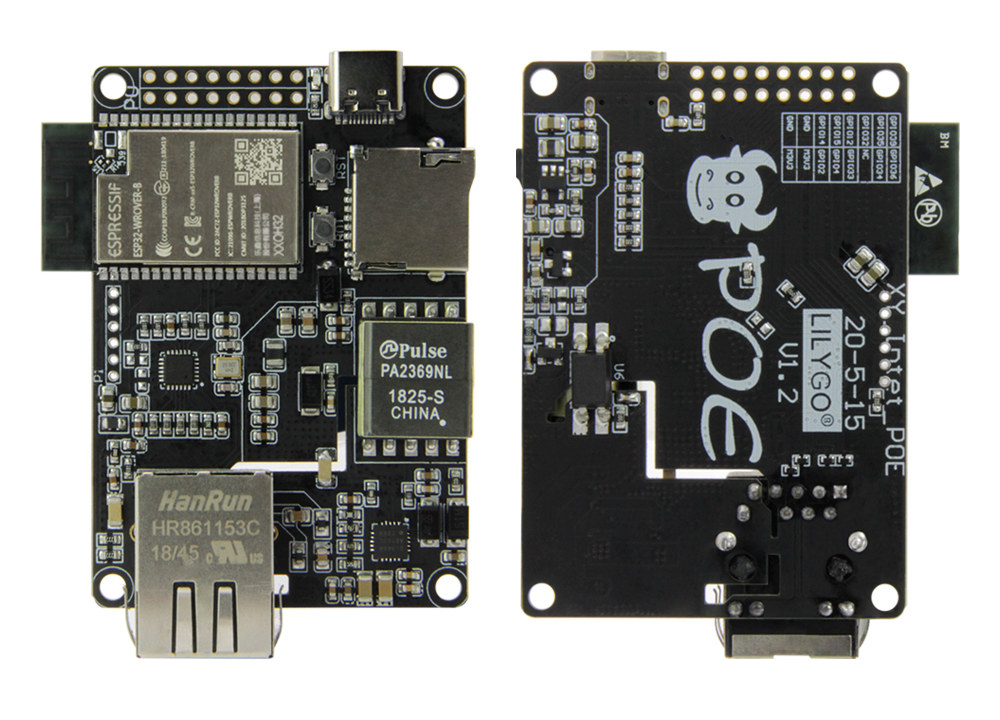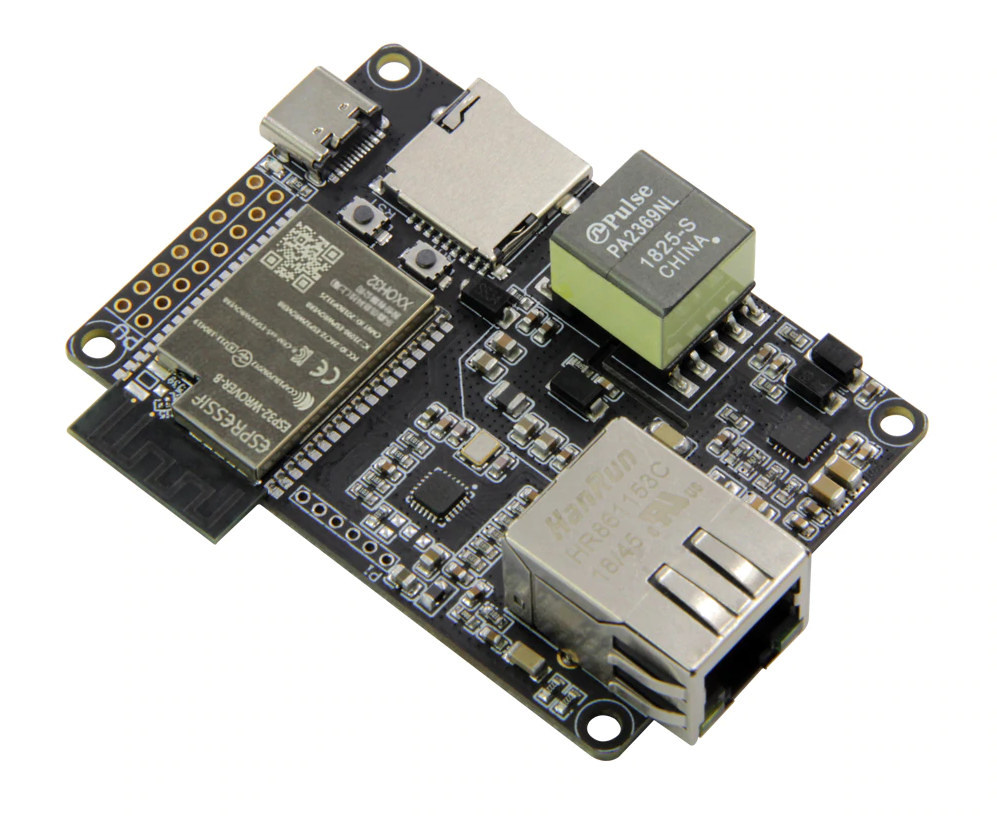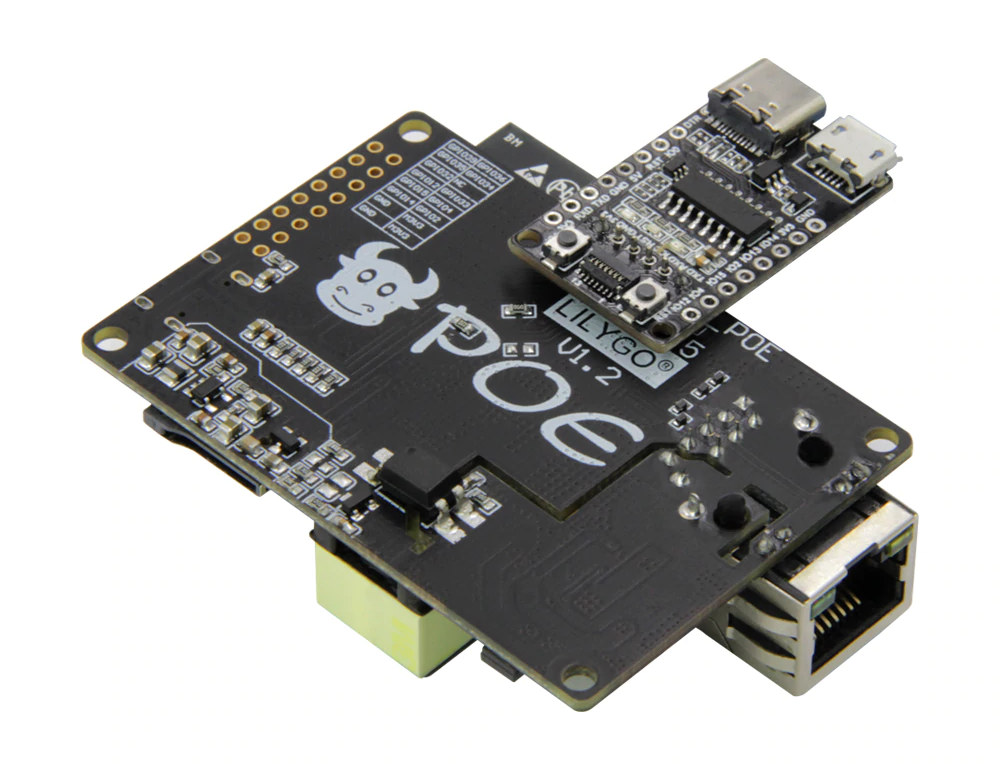We’ve written about several ESP32 POE boards in the past including wESP32, but there’s now another one with LilyGO TTGO T-Internet-POE board offering Fast Ethernet, PoE, as well as WiFI and Bluetooth connectivity through ESP32-WROVER-B module.
TTGO T-Internet-POE specifications:
- Wireless Module – ESP32-WROVER-B with ESP32 dual-core WiSoC, 4MB flash, 8MB PSRAM
- Storage – MicroSD card socket
- Connectivity
- 2.4 GHz 802.11b/g/n WiFi 4 and Bluetooth 5.1 via ESP32
- 10/100M Ethernet via LAN8720A Ethernet PHY
- Expansion – Unpopulated I/O header with UART, SPI, I2C, PWM, I2S, ADC; 3.3V I/O voltage
- Debugging / Programming
- Serial port via USB-C port and CP2104 USB to TTL chip (TBC)
- 6-pin programming interface with Tx/Rx, IO0, Reset, 3.3V and GND
- Misc – BOOT and reset buttons, 32.768MHz crystal oscillator
- Power Supply
- 5V via USB-C port up
- 50V PoE via Pulse PA2369NL transformer and HanRun HR861153C PoE compliant RJ45 jack
- SI3404 power management chip
- Dimensions – 70 x 52.3 x 17mm
- Weight – 26.85 grams
- Temperature range – -40°C to +85°C

There’s no much in terms of software apart from an Arduino Sketch initializing Ethernet and connecting to Baidu.
I’m not sure why the 6-pin programming interface is needed, but a separate CH340C based “Downloader” board with Micro USB and USB-C ports is sold as an option with the board. ESP32 should be programmable via the USB-C port unless the specs are wrong, and there isn’t any on-board CP2104 chip… The board photos are not clear enough to confirm…
LilyGO TTGO T-Internet-POE board is sold with a dual-row header for GPIO pin on Aliexpress for $15.77 plus shipping. The Downloader board found on the same page adds $1.15 to the total.

Jean-Luc started CNX Software in 2010 as a part-time endeavor, before quitting his job as a software engineering manager, and starting to write daily news, and reviews full time later in 2011.
Support CNX Software! Donate via cryptocurrencies, become a Patron on Patreon, or purchase goods on Amazon or Aliexpress







Seems like a nice board for HomeAssistant presence tracking. PoE to wherever it is wanted, monitors for BLE and WiFi MAC addresses, report over MQTT.
the CP2104 seems invisible
the operating temperature -40+85C is not possible if they use LAN8720A
and of course no schematic to verify all listed features …
With an additional CAN PHY, it could make a nice cheap CAN to IP bridge.
ESP32S seems to have a USB stack, removing the need for a USB-serial converter.
Yes, but the ESP32S lacks Bluetooth (and the second core IIRC). Not sure why they removed it.
Sprite which is now employed by Espressif describe why in a esp32.com post (https://www.esp32.com/viewtopic.php?f=2&p=58956#p58716):
> Because we’re trying to build chips for which there is a market demand, and that doesn’t always mean bigger, faster & better in all aspects. The ESP32-S2 is placed in the market as a cost-efficient chip; you can already see it’s cheaper than the ESP32. We will be developing higher-range chips as well, and the upgrades in peripheral set will be included in those as well. (And the plan is to have those upgraded chips on the market pretty fast as well; we’re not keen on taking anywhere near as long as the time between the ESP32 and ESP32-S2 anymore)
Wonder if the board has decent isolation to actually meet 803.3af standards? That usually introduces additional cost (see Olimex ESP32-POE, not isolated, at 17.95 EUR and ESP32-POE-ISO, isolated, at 24.95 EUR). Not sure if that transformer (and the cutout in the board) is enough for that?
Another gadget with an ESP32 and PoE is AprBrother’s BLE Gateway 4.0: ESP32, nRF52832 and PoE in a nice little enclosure. Can’t wait for the nRF52840 version so we can get a cheap Zigbee PoE gateway! Lacks access to I/O for tinkering though 🙁
That’s definitely a real transformer (with two coils), not just an inductor, and it has two sides to maximize the breakdown voltage. In addition there’s a trench cut in the board between the low and the high voltage areas, so I think the isolation was really done with particular care and I would really not worry about it.
Is that pulse branded transformer also including a dc/dc converter? I suppose the ethernet magnetics are integrated into the hanrun magjack and not in the pulse transformer…
The DC-DC converter is one of the chips around, on the high-voltage side. There’s even an opto-coupler on one side to report the output voltage back to the regulator.
Does anyone have any experience using ESP32 in a WiFi AP (access point) type application?
What I have in mind would be low data throughput but a moderate/high device/connection count. Somewhere on the order of 25 active/simultaneous connections.